 |
 |
||||
 |
|||||
(Q) What Is Our Research Aim and Goal?
(A) Our research group studies molecular mechanisms of interesting developmental phenomena in insects: mimicry, metamorphosis, appendage development such as legs, antennae and wings. We are also interested in the retrotransposition mechanisms of target-specific non-LTR retrotransposons (LINEs) which integrate into the specific chromosomal sequences such as telomere, rDNA and etc. Through studying various accommodative phenomena described above at the molecular, cellular and individual level, we try to understand how the gene expression network can be altered during evolution.
I explain the major projects in our laboratory briefly below. Please click 「Related publication」to see our past papers related to each project. Important papers are marked by yellow.
1) Molecular mechanism of retrotransposition of LINE and its application
2) Molecular mechanisms of telomere targeting and its application
3) Molecular mechanism of tissue differentiation by insect hormones
4) Molecular mechanisms of camouflage and mimicry
5) A novel method for protein cross-linking
6) Molecular mechanisms of appendage development and evolution in insects
1) Molecular mechanism of retrotransposition of LINE and its application
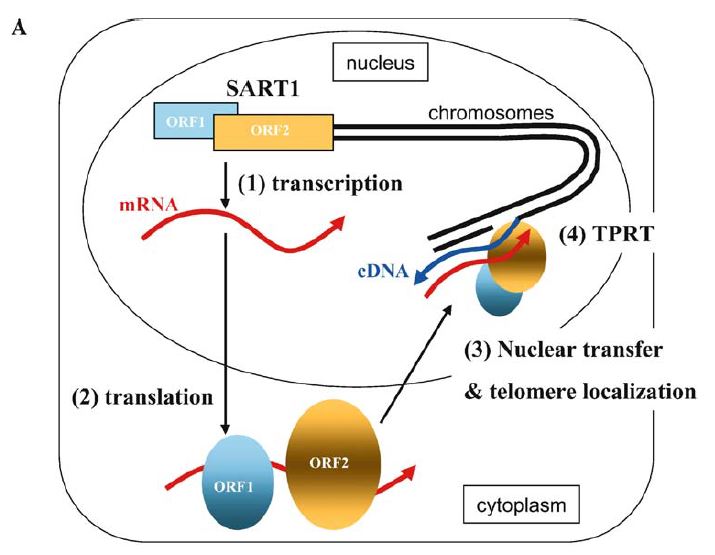
LINE occupies over 20% of the human genome and cause many genetic diseases, but retrotransposition mechanisms remain to be elucidated. We have studied target-specific LINE in insects and recently established the retrotransposition system with baculovirus-mediated gene delivery. Using this system, we continue to clarify the essential domains for LINE retrotransposition mechanisms. We are also applying this system to sequence-specific gene delivery and gene therapy vector.
2) Molecular mechanisms of telomere targeting and its application
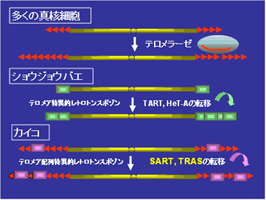
Telomere is synthesized usually by telomerase, but some insects have no or very weak telomerase activity. We found that telomeric repeat-specific LINEs backup the telomere shortening in the silkworm and that it encodes the telomeric repeat cutting enzyme. We are trying to understand maintenance and evolution of insect telomeres through the investigation of telomere specific LINEs. The anti-telomerase reagent and telomere length regulation is thought to be a potent repressor for aging and tumorigenesis. Thus, we are also analyzing cutting mechanism of the telomere cutting enzyme in LINE, and attempting to apply it to the anti-tumor reagent.
3) Molecular mechanism of tissue differentiation by insect hormones
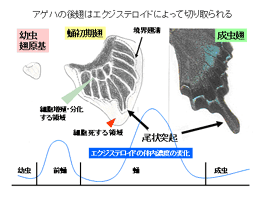
Metamorphosis which is an adaptive developmental process controlled by hormones is observed in a wide variety of animals. We have been studying wing morphogenesis in Lepidoptera and found that the steroid hormone, ecdysone, induces cell proliferation in distal wing regions and cell death in proximal wing regions. This event is controlled by region-specific expression of ecdysone receptor (EcR) isoforms. Males of the tussock moth Orgyia recens, have wings, while female moths lose their wings, which difference appears during metamorphosis. Wing morphogenesis and sexual dimorphism in Lepidoptera are good models to study steroid action during metamorphosis. We also try to understand mechanisms of larval coloration, pupal coloration, antennal differentiation through the regulation of insect hormones.
4) Molecular mechanisms of camouflage and mimicry
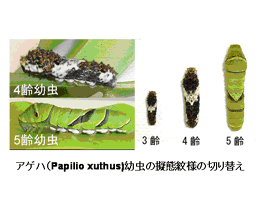
Variation of marking patterns on the body surfaces of animals is developed during evolution and useful for the lifestyle and behavior of each animal. In particular, marking patterns in insects are often used in mimicry and camouflage for protecting them from predators. We are studying the molecular mechanisms for larval body markings and wing patterns, using the silkworm mutant strains, swallowtail caterpillars which change their markings from bird dropping pattern to citrus leaves pattern during larval development, and Papilio polytes, which female shows typical Batesian mimicry.
5) A novel method for protein cross-linking
Taking a hint from the cuticle formation in insects, we are trying to develop a novel method for protein cross-linking.
6) Molecular mechanisms of appendage development and evolution in insects
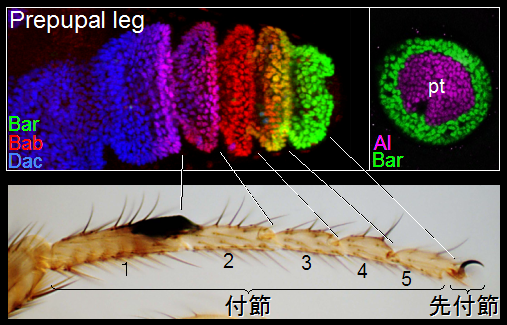
Organisms living on the earth have evolved various morphologies according to adaptive responses. Insects comprise millions of species and show immense morphological diversity, especially of the appendages, such as wings, antennae, mouthparts and legs. This extraordinary variation in morphology makes insect appendages a good model system for studying morphological evolution and diversification. We have been studying the molecular mechanisms of appendage development in a well-established model insect, Drosophila melanogaster, and by comparing the process of appendage formation in Drosophila with those in other insects at the molecular level, we are trying to understand the molecular mechanisms of morphological evolution and diversification.
Back to home
|
|
|
| All Rights Reserved, Copyright(C), Laboratory of Innovational Biology, Department of Integrated Biosciences, Graduate School of Frontier Sciences, The University of Tokyo |